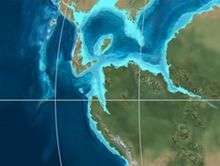Paja Formation
| Paja Formation Stratigraphic range: Hauterivian - Aptian | |
|---|---|
 Colombia during the Early Cretaceous. | |
| Type | Geological formation |
| Sub-units |
Lutitas Negras Inferiores Member |
| Underlies | Tablazo Formation |
| Overlies | Rosablanca Formation |
| Lithology | |
| Other | Mudrock |
| Location | |
| Coordinates | 5.5° N, 73.5° W |
| Region | South America |
| Country |
|
| Type section | |
| Named by | Morales et al., 1958[1] |
The Paja Formation is a Mesozoic geologic formation from the Hauterivian - Aptian stages of the Early Cretaceous of central Colombia, extending in the Eastern Cordillera of the Colombian Andes in the departments of Cundinamarca, Santander and Boyaca. It mainly composed of mudrocks with nodules of sandstones and limestones, that are interpreted as part of a marginal marine deposit,[2] with anoxic zones, in the warm and shallow sea that covered most of the Colombian territory during the Cretaceous.[3] Plesiosaur, ichthyosaur, sea turtles, teleostean fishes and ammonites[4] remains are among the main fossils that have been recovered from its strata, mainly near to the modern town of Villa de Leiva in Boyaca.[5]
Paleofauna
| Taxa of the Paja Formation | ||||||
|---|---|---|---|---|---|---|
| Genus | Species | Location | Stratigraphic position | Abundance | Notes | Images |
| Kronosaurus | K. boyacensis | A large pliosaurid, and a relative of the Australian species K. queenslandicus.[6][7] |  K. boyacensis | |||
| Stenorhynchosaurus | S. munozi | Arcillolitas abigarradas Member | A small pliosaurid, over 3 meters in length. Formerly considered as a close relative of Brachauchenius lucasi from North America.[5][8] | |||
| Platypterygius | P. sachicarum | Arcillolitas abigarradas Member | A platypterygiine ichthyosaur, relative of P. americanum.[9] | Skull of Platypterygius sachicarum | ||
| Muiscasaurus | M. catheti | Arcillolitas abigarradas Member | An ophthalmosaurid ichthyosaur, that it seems have occupied a different ecological niche respect to P. sachicarum.[10] | |||
| Callawayasaurus | C. colombiensis | An elasmosaurid plesiosaur, originally classified in Alzadasaurus.[11][12] | Skull of Callawayasaurus | |||
| Padillasaurus | P. leivaensis | Arcillolitas abigarradas Member | A brachiosaurid dinosaur, that makes the first record of a terrestrial animal in the area, and the first Cretaceous brachiosaurid known outside from North America.[13] | Padillasaurus vertebrae | ||
| Desmatochelys | D. padillai | Arcillolitas abigarradas Member | A species of the genus Desmatochelys, sea turtles that belongs to the extinct family Protostegidae. Is the oldest known sea turtle.[14] | |||
| Leyvachelys | Leyvachelys cipadi | Arcillolitas abigarradas Member | A durophagous turtle member of the Sandownidae; is the first record for this group in South America. This species occurs too in the Glen Rose Formation in USA.[15] | |||
Ammonites Pulchellia Gerhardtia Toxancycloceras Karsteniceras Prodesheyesites
References
- ↑ Morales , J., et al (1958): General Geology and Oil Occurrences of Middle Magdalena Valley, Colombia. AAPG habitat of oil symposium, p. 641-695
- ↑ Forero, H. & Sarmiento, L. 1985. La facies evaporítica de la Formación Paja en la región de Villa de Leiva. In Etayo-Serna, F. & Montaño, F. L. (eds.): Proyecto Cretácico. – Publicaciones geológicas especiales del INGEOMINAS 16 (17): 1–16.
- ↑ Gaona-Narvaez, T., Florentin, J. M. M., & Etayo-Serna, F. (2013). Geochemistry, palaeoenvironments and timing of Aptian organic-rich beds of the Paja Formation (Curití, Eastern Cordillera, Colombia). Geological Society, London, Special Publications, 382(1), 31-48.
- ↑ Patarroyo, P. (2010). Amonitas de un nivel de alta energía del Barremiano inferior en la Formación Paja de los sectores de Villa de Leyva (Boyacá) y de Vélez (Santander). Boletín de Geología, 31(2).
- 1 2 Hampe, O. (2005). Considerations on a Brachauchenius skeleton (Pliosauroidea) from the lower Paja Formation (late Barremian) of Villa de Leyva area (Colombia). Fossil Record, 8(1), 37-51.
- ↑ Acosta, C. E., Huertas, G. & Ruiz, P. M. 1979. Noticia preliminar sobre el hallazgo de un presunto Kronosaurus (Reptilia: Dolichorhynchopidae) en el Aptiano superior de Villa de Leiva, Colombia. – Lozania (Acta Zoologica Colombiana) 28: 1–7.
- ↑ Hampe, O. 1992. Ein großwu¨ chsiger Pliosauride (Reptilia:Plesiosauria) aus der Unterkreide (oberes Aptium) von Kolumbien. – Courier Forschungsinstitut Senckenberg, 145: 1–32
- ↑ Páramo, María E.; Gómez-Pérez, Marcela; Noé, Leslie F.; Etayo, Fernando (2016-04-06). "Stenorhynchosaurus munozi, gen. et sp. nov. a new pliosaurid from the Upper Barremian (Lower Cretaceous) of Villa de Leiva, Colombia, South America". Revista de la Academia Colombiana de Ciencias Exactas, Físicas y Naturales. 40 (154): 84–103. doi:10.18257/raccefyn.239. ISSN 2382-4980.
- ↑ Páramo, M. E. 1997. Platypterygius sachicarum (Reptilia,Ichthyosauria) nueva especie del Cretácico de Colombia.– Revista INGEOMINAS 6: 1–12.
- ↑ Erin E. Maxwell, Daniel Dick, Santiago Padilla and Mary Luz Parra (2015). "A new ophthalmosaurid ichthyosaur from the Early Cretaceous of Colombia". Papers in Palaeontology. in press. doi:10.1002/spp2.1030.
- ↑ Welles, S. P. 1962. A new species of elasmosaur from the Aptian of Colombia and a review of the Cretaceous plesiosaurs. –University of California Publications in Geological Sciences 44 (1): 1–96.
- ↑ Carpenter, K. 1999. Revision of North American elasmosaurs from the Cretaceous of the Western Interior. – Paludicola 2 (2):148–173.
- ↑ José L. Carballido, Diego Pol, Mary L. Parra Ruge, Santiago Padilla Bernal, María E. Páramo-Fonseca and Fernando Etayo-Serna (2015). "A new Early Cretaceous brachiosaurid (Dinosauria, Neosauropoda) from northwestern Gondwana (Villa de Leiva, Colombia)". Journal of Vertebrate Paleontology. Online edition: e980505. doi:10.1080/02724634.2015.980505.
- ↑ Cadena, Edwin A.; Parham, James F. (2015). "Oldest known marine turtle? A new protostegid from the Lower Cretaceous of Colombia". PaleoBios. 32 (1): 1–42.
- ↑ Edwin Cadena (2015). "The first South American sandownid turtle from the Lower Cretaceous of Colombia". PeerJ. 3: e1431. doi:10.7717/peerj.1431.